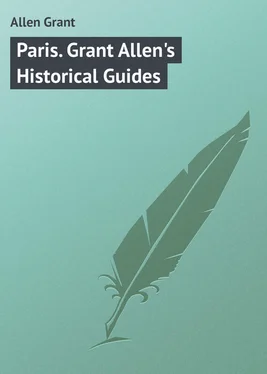Grant Allen - Paris. Grant Allen's Historical Guides
Здесь есть возможность читать онлайн «Grant Allen - Paris. Grant Allen's Historical Guides» — ознакомительный отрывок электронной книги совершенно бесплатно, а после прочтения отрывка купить полную версию. В некоторых случаях можно слушать аудио, скачать через торрент в формате fb2 и присутствует краткое содержание. ISBN: , Издательство: Иностранный паблик, Жанр: foreign_language, foreign_prose, на английском языке. Описание произведения, (предисловие) а так же отзывы посетителей доступны на портале библиотеки ЛибКат.
- Название:Paris. Grant Allen's Historical Guides
- Автор:
- Издательство:Иностранный паблик
- Жанр:
- Год:неизвестен
- ISBN:http://www.gutenberg.org/ebooks/49907
- Рейтинг книги:4 / 5. Голосов: 1
-
Избранное:Добавить в избранное
- Отзывы:
-
Ваша оценка:
- 80
- 1
- 2
- 3
- 4
- 5
Paris. Grant Allen's Historical Guides: краткое содержание, описание и аннотация
Предлагаем к чтению аннотацию, описание, краткое содержание или предисловие (зависит от того, что написал сам автор книги «Paris. Grant Allen's Historical Guides»). Если вы не нашли необходимую информацию о книге — напишите в комментариях, мы постараемся отыскать её.
Paris. Grant Allen's Historical Guides — читать онлайн ознакомительный отрывок
Ниже представлен текст книги, разбитый по страницам. Система сохранения места последней прочитанной страницы, позволяет с удобством читать онлайн бесплатно книгу «Paris. Grant Allen's Historical Guides», без необходимости каждый раз заново искать на чём Вы остановились. Поставьте закладку, и сможете в любой момент перейти на страницу, на которой закончили чтение.
Интервал:
Закладка:
Room IV. – Fine Renaissance chimney-piece, by Hugues Lallement, 16th century, representing Actæon transformed into a stag by Diana, whom he has surprised in the act of bathing. (Subjects from the myth of Diana are favourites with the French Renaissance artists, owing to the influence of Diane de Poitiers.) From Châlons-sur-Marne, same house as that in Room II. Wall A(1779 and 1778), Renaissance classical paintings, part of a large series continued elsewhere; (1428) fine Renaissance carved cabinet (Diana and Chimæras); contrast this and neighbouring Renaissance work with the mediæval carvings in adjacent rooms. Wall B(6329), quaint old Flemish tapestry, representing the Angels appearing to the Shepherds; the Nativity; the Adoration of the Magi; and the Agony in the Garden. Study the arrangement of all these figures, which are conventional, and will reappear in many other examples of various arts. Wall C, R and L of fireplace, good Renaissance wood-carving. Wall D, fine cabinets. In the cases, medals.
Room V, to the side. Debased Italian and Spanish workof the 17th and 18th centuries. Centre, Adoration of the Magi, a meretricious Neapolitan group of the 17th century, intended to place in a church as a Christmas berceau . The costumes of the Three Kings, representing the three continents, the ruined temple in which the action takes place, and the antique statue in the background of the Madonna and St. Joseph, should all be noticed. Contemptible as a work of art, this florid composition of dolls is interesting and valuable for its spirited arrangement, and for the light it casts on the conception of the subject. The room also contains other similar church furniture of the 17th and 18th centuries. Observe their theatrical tinsel style and their affected pietism, as contrasted with the simplicity, naïveté, and truth of earlier periods. Take, as an extreme example of this tendency, the relief of the Annunciation on Wall D, to the R of the entrance door, and compare it with examples of the same subject in other rooms of the collection. Wall B, facing the entrance, good case of miscellaneous woodwork containing excellent Spanish art of this bad period – a Last Supper, a St. Francis receiving the Stigmata, a Massacre of the Innocents, the Faint of St. Catherine, St. Antony the Abbot, St. Antony of Padua carrying the infant Christ, and other figures. A large gilt tabernacle, on Wall C, also contains a debased figure of St. Anthony of Padua, from an altar dedicated to the Saint. Identify as many of these saints as possible, and remember their symbols.
We now quit the older suite of apartments, and enter a large central glass-covered court – Room VI, entirely modern. The Corridoris occupied by early altar paintings, for the most part of little value. Notice on the L, by the staircase (1701), a Giottesque Madonna and Child – Florentine, 15th century. Near it (1666), two oval panels, representing the Annunciation, divided (as frequently happens with this subject) into two distinct portions, and probably flanking a doorway in their original position – Italian, 14th century. All the paintings on this wall, mostly unsatisfactory as works of art, are valuable for their symbolism and the light they throw on the evolution of their subjects. For example: (1676), between the Annunciation pictures, represents the distribution of holy wine which has touched the relics (I think) of St. Hubert. Further on, we have a group of six Apostles; beginning from the R, St. Peter with the keys, St. John Evangelist with the cup and serpent, St. Andrew with his cross, St. Bartholomew with his knife, St. James the Greater with the pilgrim’s staff and scallop, and St. James the Less with a crosier and book. R of the staircase is a stone figure of St. Denis bearing his head, French, 15th century; also, a good statue of the Madonna, a little later. Above the doorway, R, are portions of a large Spanish altar-piece; in the centre, the Crucifixion; extreme R, Assumption of the Virgin, etc. Beyond it comes the continuation of the tabernacle already noticed, containing the six remaining Apostles, with the symbols of their martyrdom. Next, a fine Spanish altar-piece of the 15th century, from a church of St. Martin; in the centre, St. Martin dividing his cloak with the beggar; round it various other subjects, among them St. Antony with his pig, St. Stephen, in deacon’s robes, with the stones of his martyrdom, St. Jerome in the desert beating his bosom with a flint before the crucifix, St. Francis displaying the stigmata or five wounds of Christ, St. Paul the hermit with his lion, etc. R, towards the courtyard, a fine figure of Adam from St. Denis, a splendid example of the best French nude sculpture of the 14th century.
We now enter the covered courtyardor Room VI proper, filled with fine examples of French mediæval sculpture. Several of the objects bear labels sufficiently descriptive. I will therefore only call attention to a few among them. Wall D, two wooden Flemish statues (Our Lady and St. John at Calvary), R and L of the doorway; (417) carved marble monument of the 10th or 11th century; very fine workmanship, with distinct reminiscences of the antique. Wall A, *Magnificent stone frieze or reredos, originally gilt and coloured, representing the History of St. Benedict, from St. Denis; in the centre, Baptism in Jordan (compare the relief of the same subject in Notre-Dame); R and L, preaching and miracles of St. Benedict (overthrow of idols, cure of a dying woman). Middle of wall (6328), fine Italian tapestry, 16th century, representing the Adoration of the Magi; observe the attitude of the kings, together with the ox and ass in the background, invariable concomitants of the Nativity in art. Beneath (728), early wooden Madonna (13th century, Auvergne), with Byzantine aspect. Beautiful Romanesque capitals – Creation of Eve, etc. Wall B*(237), exquisite stone frieze or reredos from the church of St. Germer, about 1259, much-mutilated, but originally one of the most perfect specimens of French 13th century carving; it still betrays traces of colour. In the centre, Crucifixion, with Virgin and St. John: on either side (as at Notre-Dame), the Church, with cross and chalice, and the Synagogue, with eyes blinded: then, R and L of cross, St. Peter and St. Paul: beyond them, Annunciation and Visitation: finally, L, St. Ouen, uncle of St. Germer, cures a wounded warrior; R, St. Germer asks leave of King Dagobert to found the Abbey from which this came. Above it (509), exquisitely grotesque relief of the Resurrection with sleeping Roman soldiers, one of a set in alabaster, French 14th century (500 to 512), all of which deserve to be inspected; meanings of all are obvious except (501) St. Ursula. Still higher, fragment of the original Last Judgment on the central west door of Notre-Dame, Paris, before the restoration – interesting as showing the grounds on which Viollet-le-Duc proceeded; (6322), tapestry, Arras, 15th century, various scriptural subjects, confused, but decipherable. Beneath it, L, *beautiful stone relief (reredos) of the legend of St. Eustace, from the church of St. Denis – a fine French work of the 14th century. In the centre, Crucifixion; extreme L, St. Eustace, hunting, is converted by the apparition of the Christ between the horns of the stag he is pursuing; further R, his baptism, nude, in a font, as in all early representations; still further R, his trials and history; while he crosses a river with one of his children, a wolf seizes one, while a lion devours the other; last of all, reunited miraculously with his family, he and they are burned alive as martyrs by the Emperor Trajan, in a brazen bull. Observe naïf boy with bellows. The whole most delicately and gracefully sculptured. Next, coloured stone relief of the Passion – French 14th century; subjects, from R to L: the kiss of Judas (observe Peter drawing the sword); Flagellation; Bearing of the Cross, with Simon of Cyrene; Deposition in the Tomb; Resurrection; and Christ in Hades, delivering Adam and Eve from the jaws of death, realistically represented here and elsewhere as the mouth of a monster; notice in this work the colour and the Gothic architecture and decoration of the background, which help one to understand features that are missing in many other of these reredoses. Then, stone relief of the Annunciation, Visitation, and Nativity, very simply treated: notice the usual ox and ass in the manger. Above it, *(4763), good mosaic of the Madonna and Child with adoring angels, by Davide Ghirlandajo, of Florence, placed by the President Jean de Ganay (as the inscription attests) in the church of St. Merri at Paris. Wall C(513–518), interesting alabaster reliefs of the Passion, French, 14th century. Between them, Coronation of the Virgin, French, 15th century. (725) Good wooden figure of St. Louis, covered with fleur-de-lis in gold, from the Sainte Chapelle. [Here is the door which leads to the Musée des Thermes. Pass it by for the present.] Beyond it, continuation of the alabaster reliefs (514 and 517), etc.: examine them closely. Between them (435), Circumcision, in marble, early 15th century, French, full of character. Beneath it (429, etc.), admirable figures of mourners, from the tomb of Philippe le Hardi, at Dijon, 14th century. Wall D, again (1291), terra-cotta, coloured: Madonna and St. Joseph, with angels, adoring the Child (child missing), ox and ass in background; R, Adoration of Magi; notice once more the conventional arrangement: L, Marriage of the Virgin, a high priest joining her hand to Joseph’s, all under Gothic canopies, 15th century, from the chapel of St. Éloy, near Bernay, Eure. I omit many works of high merit.
Читать дальшеИнтервал:
Закладка:
Похожие книги на «Paris. Grant Allen's Historical Guides»
Представляем Вашему вниманию похожие книги на «Paris. Grant Allen's Historical Guides» списком для выбора. Мы отобрали схожую по названию и смыслу литературу в надежде предоставить читателям больше вариантов отыскать новые, интересные, ещё непрочитанные произведения.
Обсуждение, отзывы о книге «Paris. Grant Allen's Historical Guides» и просто собственные мнения читателей. Оставьте ваши комментарии, напишите, что Вы думаете о произведении, его смысле или главных героях. Укажите что конкретно понравилось, а что нет, и почему Вы так считаете.












